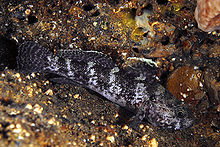Rock goby
| Rock goby | ||||||||||||
|---|---|---|---|---|---|---|---|---|---|---|---|---|

Rock goby ( Gobius paganellus ) |
||||||||||||
| Systematics | ||||||||||||
|
||||||||||||
| Scientific name | ||||||||||||
| Gobius paganellus | ||||||||||||
| Linnaeus , 1758 |
The rock goby ( Gobius paganellus) , first described in 1758 by the Swedish naturalist Carl von Linné , is one of the most common representatives of the sublittoral and occurs from the eastern Atlantic, the Mediterranean, the Black Sea to the Indian Ocean and the Red Sea. The rock goby belongs within the order of the goby-like ( Gobiiformes ) of the family of gobies ( Gobiidae ).
morphology
Gobius paganellus is a relatively large representative of the gobies and can reach a length of 48 to 122 mm in males and 39 to 125.3 mm in females. Adult animals show strong pigmentation of the rear (anterior) body section. Two horizontal strips of melanophores are formed on the first dorsal fin (dorsalis) and one horizontal strip each on the second dorsal fin (dorsalis) and the anal fin (analis). G. paganellus can reach an age of up to ten years.
distribution
The Gobiidae family represents the largest family of marine fish and plays an important role in temperate and tropical fish communities in reefs. The distribution of G. paganellus extends from western Scotland to Senegal , including oceanic islands, the Mediterranean , the Black Sea, the Gulf of Aqaba, and the Red Sea. The rock goby lives in the sublittoral and shallow waters, where it looks for shelter on rocky coasts and on muddy and sandy subsoil. Areas with lush vegetation are preferred. G. paganellus can be found up to a depth of 5 meters.
Development and way of life
The development of the gonads begins in October and moves into the spawning season from December to March. G. paganellus shows group-synchronous oocyte development. The animals reach sexual maturity from a length of 70 mm in males and 58 mm in females. The spindle-shaped (fusiform) and transparent eggs are deposited in one layer on the underside of flat stones or in mussel shells. The males play an important role in the care of the brood and guard the clutch of different females at the same time.
The 1.60 - 2.20 mm long and 0.80 - 0.90 mm wide eggs produce 3.9 mm large larvae after about 10 days, which have an open anus and an open mouth and are therefore able to to feed exogenously immediately after hatching. The egg yolk is almost completely absorbed. The newly hatched larvae are typically slender and elongated in shape, with a prominent swim bladder. Immediately after hatching, the larvae swim in spiral movements to the surface of the water, where they swallow air to fill their swim bladders. This behavior is repeated until the larvae can stabilize in the water column .
25 days after hatching, the 10.0-10.5 mm larvae begin to adapt to the benthic way of life. After 36 days, the metamorphosis to the adult fish begins at a size of about 14.0 mm. Characteristic behaviors of a benthic fish, such as jumping and hiding in the substrate, can now also be recognized.
nutrition
Gobius paganellus feeds mainly on macrozoobenthos, such as crustaceans (Crustacea), including larger amphipods, isopods and smaller crustaceans, and polycheates.
Systematics
Gobius paganellus belongs to the genus Gobius within the Gobiidae family . The rock goby belongs to the order of the goby-like (Gobiiformes) and the class of the ray-fins (Actinopterygii).
Web links
Individual evidence
- ↑ a b c d rock goby on Fishbase.org (English)
- ↑ a b c Ibtissem Louiz, Mossadok Ben Attia, Oum Kalthoum Ben Hassine: Some aspects of reproductive biology of Gobius paganellus (Gobiidae) on the north-eastern coasts of Tunisia (Bizerta lagoon) . In: Journal of the Marine Biological Association of the United Kingdom . tape 93 , no. 8 , August 8, 2013, ISSN 0025-3154 , p. 2235-2246 , doi : 10.1017 / s0025315413000982 .
- ↑ a b c Rita Borges, Cláudia Faria, Fátima Gil, Emanuel J. Gonçalves, Vitor C. Almada: Embryonic and larval development of Gobius paganellus (Pisces: Gobiidae) . In: Journal of the Marine Biological Association of the United Kingdom . tape 83 , no. 5 , September 19, 2003, ISSN 0025-3154 , p. 1151-1156 , doi : 10.1017 / s0025315403008415h .
- ^ JS Nelson Fishes of the world. 3rd edition, xvii, 600p. John Wiley and Sons, 1994. Price £ 66.00. In: Journal of the Marine Biological Association of the United Kingdom . tape 74 , no. 4 , November 1994, ISSN 0025-3154 , pp. 987-987 , doi : 10.1017 / s0025315400090378 .
- ↑ PJP Whitehead, M.-L. Bauchot, J.-C. Hureau, J. Nielsen & E. Tortonese Fishes of the North-eastern Atlantic and the Mediterranean. Volume III. pp. 1013-1473. Paris: Unesco, 1986. Price (from HMSO) £ 37.50. In: Journal of the Marine Biological Association of the United Kingdom . tape 68 , no. 1 , February 1988, ISSN 0025-3154 , pp. 217-217 , doi : 10.1017 / s0025315400050360 .
